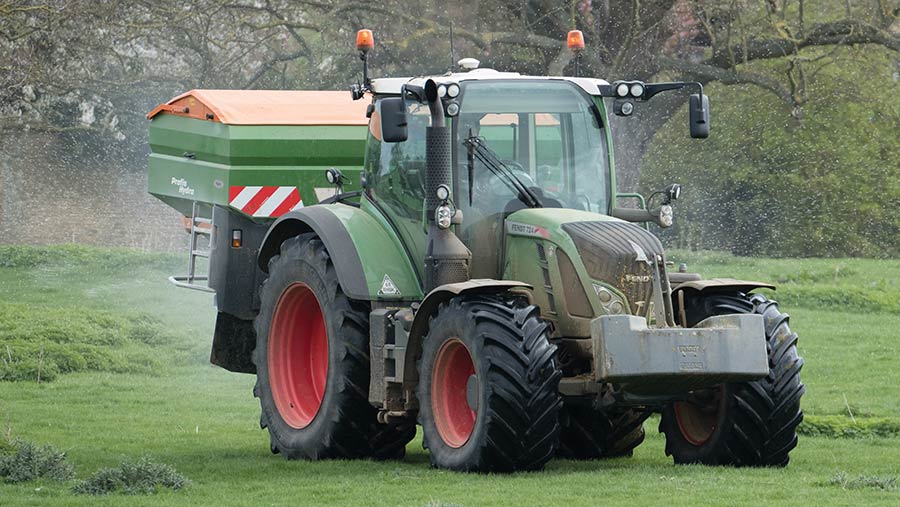Advice on efficient use of nitrogen fertiliser on grassland
 © Tim Scrivener
© Tim Scrivener Now is the time to challenge your fertiliser practices – making better use of what has become an expensive input will have a big effect on cost control and grassland yields.
“Plan and measure to make savings and be more efficient with fertiliser,” says independent consultant Dr George Fisher.
Instead of spreading fertiliser according to traditional dates and rates, he advises reviewing inputs so far this season, then targeting further amounts based on soil requirements and weather forecasts.
See also: How legumes, muck and slurry can help cut fertiliser bill
Farms facing drought conditions, for instance, should stop applications and restart when rain is next forecast.
George says it is important to consider what might still be in the soil from the previous application.
“If there is residual nitrogen, it will be released when it rains. You might get high free nitrogen, high milk ureas and silage slippage in clamps if you keep applying and ignore this residual,” he explains.
Autumn rates
He suggests working back from the closed period for applying bagged fertiliser (15 September) to calculate what to apply to make the most of the autumn flush of grass growth.
“Look at how much nitrogen has already been applied this year – as fertiliser and slurry – and what leeway you have for applying more for best results.
“Autumn grass growth just needs 30-40kg N/ha, as the soil releases nitrogen over summer, so you don’t need to apply spring rates of 50-80kg N/ha.”
Farms growing more than 12t dry matter (DM)/ha can discuss grazing application rates with a qualified adviser (particularly for farms in a nitrate vulnerable zone) to establish whether it is possible to spread another 40kg N/ha on top of the 300kgN/ha maximum allowance, if needed.
George cautions against growing grass if it cannot be grazed or clamped as silage.
Doing this is just a waste, he points out. However, there are savings to be made if it can be used.
“For every extra day grazing, compared with housing dairy cows, you can save £2.50-£3.50 a cow in costs.
“If you can get one extra week’s grazing, across a 200-cow herd, that would be worth £3,500. For those operating a multicut silage system, can you fit in another cut?”
Next season
Once the autumn grass is harvested, it is time to plan 2024’s fertiliser policy.
Risk-managing a relatively high-priced input calls for a good purchasing strategy to get the best deals.
However, George says fertiliser quantities should be based on data and soil condition to target nitrogen and growth rates on a field-by-field basis, regardless of price.
He advises reviewing soil sample results in October, taking new samples from fields that have not been tested in the previous three years to work out where to apply N – and how much.
Slurries and manures should also be tested.
“You know if soils need a top-up of phosphorus or potassium [from soil analysis results].
“Liming can be done in September/October or February, but use calcium lime products, as magnesium lime can affect soil structure and make it sticky.
“Don’t forget sulphur – add it to every application of nitrogen unless you are on very heavy clay or organic soils. It’s best used little and often, up to 100kg/ha of sulphate in a season.”
2024 fertiliser planning checklist
- Look after soils: dig holes to inspect compaction and drainage
- Review soil analyses
- Calculate how much grazing and silage you need
- Establish which paddocks grew the most grass
- Identify underperforming fields
- Get slurry and muck tested for nutrient content
- Work out what improvements are needed: lime, potassium, phosphate, sulphur
